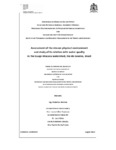Use este identificador para citar ou linkar para este item:
http://www.alice.cnptia.embrapa.br/alice/handle/doc/950769Registro completo de metadados
| Campo DC | Valor | Idioma |
|---|---|---|
| dc.contributor.author | WERNER, F. | pt_BR |
| dc.date.accessioned | 2013-02-25T11:11:11Z | pt_BR |
| dc.date.available | 2013-02-25T11:11:11Z | pt_BR |
| dc.date.created | 2013-02-25 | pt_BR |
| dc.date.issued | 2012 | pt_BR |
| dc.identifier.citation | 2012. | pt_BR |
| dc.identifier.uri | http://www.alice.cnptia.embrapa.br/alice/handle/doc/950769 | pt_BR |
| dc.description | In last decades, water resources around the world have been severely degraded as a consequence of the expansion of areas under human utilization and lack of adequate management. Simultaneously, awareness has increased about the interactions between the environmental condition of river basins and the quality of water resources they provide. Today, in the context of water resources management, the importance of monitoring the environmental condition of basins is fundamental. Among the several methodological approaches available with this purpose, the recent trend is the use of rapid assessment methods, based on a visual inspection of specific indicators of the health of fluvial ecosystems. The Guapi-Macacu rivers basin (GMB), located northeast of the Guanabara Bay in the Brazilian State of Rio de Janeiro, is an area characterized by its abundant water resources. However, pressure over them is rising due to growing population and industrial activities. The area presents a heterogeneous mosaic of land uses, with increasing intensity from the upper zones to the lowlands. The objective of this research was to study the river environment condition in the GMB and if it can be related to water quality of the rivers. Initially, an assessment of the river ecosystem was carried out. It was focused on the river?s physical environment (RPE), that is, the morphological and structural characteristics of the river ecosystems. For the field survey, an existent protocol was used, which was selected primarily according the group of elements from the RPE it proposes to evaluate, and how. The survey was carried out in 27 points distributed in the GMB with focus on three sub-basins with particular land use cover and for which water quality data was available. An indexed score was then obtained for each site expressing its RPE?s environmental condition. For the analysis of patterns from these scores, they were mapped to obtain a spatial overview. Also the correlation between scores and water quality data was calculated. The assessment method functioned well in order to describe the RPE?s conditions in the GMB, which deteriorate from up to downstream, together with increasing land use intensity. The correlation analysis showed interactions between scores and some water quality parameters. For other parameters, patterns resulted less clear due to the highly complex links between both elements. | pt_BR |
| dc.format | il. color. | pt_BR |
| dc.language.iso | eng | eng |
| dc.rights | openAccess | eng |
| dc.subject | SVAP | pt_BR |
| dc.subject | River rapid assessment | pt_BR |
| dc.subject | Brazilian Atlantic Forest | pt_BR |
| dc.subject | Water resources management | pt_BR |
| dc.title | Assessment of the stream physical environment and study of its relation with water quality in the Guapi-Macacu watershed, Rio de Janeiro, Brazil. | pt_BR |
| dc.type | Teses | pt_BR |
| dc.date.updated | 2017-05-26T11:11:11Z | pt_BR |
| dc.subject.nalthesaurus | water quality | pt_BR |
| dc.description.notes | Thesis (Master of Science) - Universidad Autónoma de San Luis Potosí, México; Cologne University of Applied Sciences, Cologne, Germany. Co-director: Laura Yáñez Espinosa; Lars Ribbe; Rachel Bardy Prado, CNPS. | pt_BR |
| dc.format.extent2 | 84 f. | pt_BR |
| riaa.ainfo.id | 950769 | pt_BR |
| riaa.ainfo.lastupdate | 2017-05-26 | pt_BR |
| dc.contributor.institution | FEDERICO WERNER, UNIVERSIDAD AUTÓNOMA DE SAN LUIS POTOSÍ. | pt_BR |
| Aparece nas coleções: | Tese/dissertação (CNPS)  | |
Arquivos associados a este item:
| Arquivo | Descrição | Tamanho | Formato | |
|---|---|---|---|---|
| 2012pmpcamwerner1208281.pdf | 2,38 MB | Adobe PDF |  Visualizar/Abrir |









